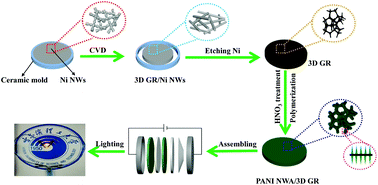High-performance supercapacitors based on polyaniline nanowire arrays grown on three-dimensional graphene with small pore sizes†
Abstract
Three-dimensional graphene (3D GR)-based hybrids have received significant attention due to their unique structures and promising applications in supercapacitors. In this paper, 3D GR with small pore sizes has been prepared by chemical vapor deposition using commercial nickel nanowires as the template. After nitric acid treatment, the hydrophilicity of 3D GR improved. Polyaniline nanowire arrays (PANI NWAs) have been successfully grown on its surface by in situ polymerization to obtain hybrid PANI NWA/3D GR. The results show that PANI NWAs with a length of ∼300 nm vertically grow on 3D GR with a pore diameter of ∼2 μm. The small pore size of 3D GR not only improves the mechanical properties of 3D GR, but also provides numerous sites for the growth of PANI NWAs. Meanwhile, PANI NWAs provide a shorter ion diffusion path and larger contact area with the electrolyte. Due to the unique structure, the hybrid exhibits a high specific capacitance of 789.9 F g−1 at 10 mV s−1. When it is assembled into a symmetric supercapacitor, it exhibits an energy density of 32.2 W h kg−1 at a power density of 793.3 W kg−1 and maintains a good cycle stability of 90% after 5000 cycles at 1.0 A g−1.



 Please wait while we load your content...
Please wait while we load your content...